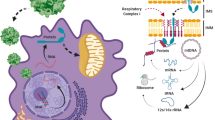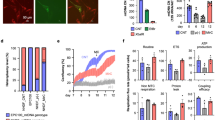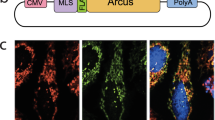Abstract
Here we investigated the pathogenesis of deletion mutant mitochondrial (mt)DNA by generating mice with mutant mtDNA carrying a 4696-basepair deletion (ΔmtDNA4696), and by using cytochrome c oxidase (COX) electron micrographs to identify COX activity at the individual mitochondrial level. All mitochondria in tissues with ΔmtDNA4696 showed normal COX activity until ΔmtDNA4696 accumulated predominantly; this prevented mice from expressing disease phenotypes. Moreover, we did not observe coexistence of COX-positive and -negative mitochondria within single cells. These results indicate the occurrence of inter-mitochondrial complementation through exchange of genetic contents between exogenously introduced mitochondria with ΔmtDNA4696 and host mitochondria with normal mtDNA. This complementation shows a mitochondria-specific mechanism for avoiding expression of deletion-mutant mtDNA, and opens the possibility of a gene therapy in which mitochondria possessing full-length DNA are introduced.
This is a preview of subscription content, access via your institution
Access options
Subscribe to this journal
Receive 12 print issues and online access
$209.00 per year
only $17.42 per issue
Buy this article
- Purchase on Springer Link
- Instant access to full article PDF
Prices may be subject to local taxes which are calculated during checkout






Similar content being viewed by others
References
Larsson, N.-G. & Clayton, D.A. Molecular genetic aspects of human mitochondrial disorders. Annu. Rev. Genet. 29, 151–178 (1995).
Wallace, D.C. Mitochondrial diseases in man and mouse. Science 283, 1482–1488 (1999).
Wang, J. et al. Dilated cardiomyopathy and atrioventricular conduction blocks induced by heart-specific inactivation of mitochondrial DNA gene expression. Nature Genet. 21, 133–137 (1999).
Yamaoka, M. et al. Complete repopulation of mouse mitochondrial DNA-less cells with rat mitochondrial DNA restores mitochondrial translation but not mitochondrial respiratory functions. Genetics 155, 301–307 (2000).
Yamaoka, M., et al. Mice with only rat mtDNA are required as models of mitochondrial diseases. Biochem. Biophys. Res. Commun. 282, 707–711 (2001).
Inoue, K. et al. Isolation and characterization of mitochondrial DNA-less mouse cell lines and their application for trapping mouse synaptosomal mitochondrial DNA with deletion mutations. J. Biol. Chem. 272, 15510–15515 (1997).
Inoue, K. et al. Generation of mice with mitochondrial dysfunction by introducing mouse deletion mutant mtDNA into zygotes. Nature Genet. 26, 176–181 (2000).
Kaneda, H. et al. Elimination of paternal mitochondrial DNA in intraspecific crosses during early mouse embryogenesis. Proc. Natl. Acad. Sci. USA 92, 4542–4546 (1995).
Shitara, H. et al. Selective and continuous elimination of mitochondria microinjected into mouse eggs from spermatids, but not from liver cells, occurs throughout embryogenesis. Genetics 156, 1277–1284 (2000).
Yoneda, M., Miyatake, T. & Attardi, G. Complementation of mutant and wild-type human mitochondrial DNAs coexisting since the mutation event and lack of complementation of DNAs introduced separately into a cell with distinct organelles. Mol. Cell. Biol. 14, 2699–2712 (1994).
Lombes, A., Bonilla, E. & DiMauro, S. Mitochondrial encephalomyopathies. Rev. Neurol. 145, 671–689 (1989).
Muller-Hocker, J. Mitochondria and aging. Brain Pathol. 2, 149–158 (1992).
Szabolcs, M.J. et al. Mitochondrial DNA deletion: a cause of chronic tubulointerstitial nephropathy. Kidney Int. 45, 1388–1396 (1994).
Sciacco, M. et al. Distribution of wild-type and common deletion forms of mtDNA in normal and respiration-deficient muscle fibers from patients with mitochondrial myopathy. Hum. Mol. Genet. 3, 13–19 (1994).
Hayashi, J.-I. et al. Introduction of disease-related mitochondrial DNA deletions into HeLa cells lacking mitochondrial DNA results in mitochondrial dysfunction. Proc. Natl. Acad. Sci. USA 88, 10614–10618 (1991).
Clayton, D.A. Transcription of the mammalian mitochondrial genome. Ann. Rev. Biochem. 53, 573–594 (1984).
Ono, T., Isobe, K., Nakada, K. & Hayashi, J.-I. Human cells are protected from mitochondrial dysfunction by complementation of DNA products in fused mitochondria, Nature Genet. 28, 272–275 (2001).
Hayashi, J.-I., Takemitsu, M., Goto, Y.-i. & Nonaka, I. Human mitochondria and mitochondrial genome function as a single dynamic cellular unit. J. Cell Biol. 125, 43–50 (1994).
Ito, S. et al. Functional integrity of mitochondrial genomes in human platelets and autopsied brain tissues from elderly patients with Alzheimer's disease. Proc. Natl. Acad. Sci. USA 96, 2099–2103 (1999).
Seligman, A.M., Karnovsky, M.J., Wasserkrug, H.L. & Hanker, J.S. Nondroplet ultrastructural demonstration of cytochrome oxidase activity with a polymerizing osmophilic reagent, diaminobenzidine (DAB). J. Cell Biol. 38, 1–14 (1968).
Miyabayashi, S. et al. Cytochrome c oxidase deficiency in two siblings with Leigh encephalomyelopathy. Brain Dev. 6, 362–372 (1984).
Nonaka, I., Koga, Y., Ohtaki, E. & Yamamoto, M. Tissue specificity in cytochrome c oxidase deficient myopathy. J. Neurol. Sci. 92, 193–203 (1989).
Acknowledgements
This work was supported by a grant for a Research Fellowship from the Japan Society for Promotion of Science for Young Scientists (to K.N., K.I. and K.I.); by a grant for the Hayashi project of TARA, University of Tsukuba; by Grants-in-Aid for Scientific Research from the Ministry of Education, Culture, Sports, Science and Technology of Japan (to J.-I.H.); and by Health Sciences Research Grants for Research on Brain Science from the Ministry of Health and Welfare of Japan (to J.-I.H, I.N. and Y.-i.G.).
Author information
Authors and Affiliations
Corresponding author
Rights and permissions
About this article
Cite this article
Nakada, K., Inoue, K., Ono, T. et al. Inter-mitochondrial complementation: Mitochondria-specific system preventing mice from expression of disease phenotypes by mutant mtDNA. Nat Med 7, 934–940 (2001). https://doi.org/10.1038/90976
Received:
Accepted:
Issue Date:
DOI: https://doi.org/10.1038/90976
This article is cited by
-
UCP2 and pancreatic cancer: conscious uncoupling for therapeutic effect
Cancer and Metastasis Reviews (2024)
-
Mesenchymal stem cells improve redox homeostasis and mitochondrial respiration in fibroblast cell lines with pathogenic MT-ND3 and MT-ND6 variants
Stem Cell Research & Therapy (2022)
-
Mitochondrial changes in fish cells in vitro in response to serum deprivation
Fish Physiology and Biochemistry (2022)
-
Mitochondrial Dynamin-Related Protein Drp1: a New Player in Cardio-oncology
Current Oncology Reports (2022)
-
Cerebral Vascular Toxicity of Antiretroviral Therapy
Journal of Neuroimmune Pharmacology (2021)



